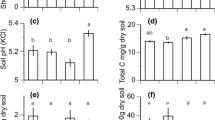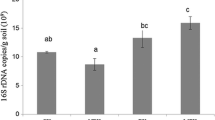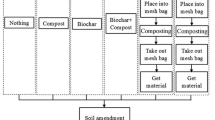Abstract
A 4-month field experiment was conducted in an organic vegetable production system; two crops, Brassica chinensis and Cichorium endivia L., were cultivated successively and treated with 0 (CKC), 30 (PC1), 60 (PC2), or 120 (PC3) t ha−1 of pig manure-based compost. The replicated and heavy application of pig manure-based compost increased the total amounts of some heavy metals (Zn, Cu, Pb, and Cd) in the short term in soil. Despite the Shannon (bacterial diversity), Chao1 (richness), and evenness indices of different samples calculated after pyrosequencing analysis were similar, changes occurred in the bacterial community composition in soils amended with different rates of compost. The joint cluster and principal component analysis (PCA) indicated that heavy rates of compost may not change bacterial diversity in the short term and, in some cases, even produce a lower genetic diversity. The optimum rate, as well as the period, for compost application should be evaluated to promote the sustainable development of organic agriculture.





Similar content being viewed by others
References
Achiba WB, Gabteni N, Lakhdar A, Laing GD, Verloo M, Jedidi N, Gallali T (2009) Effects of 5-year application of municipal solid waste compost on the distribution and mobility of heavy metals in a Tunisian calcareous soil. Agr Ecosyst Environ 130:156–163
Achiba WB, Lakhdar A, Gabteni N, Laing GD, Verloo M, Boeckx P, Cleemput OV, Jedidi N, Gallali T (2010) Accumulation and fractionation of trace metals in a Tunisian calcareous soil amended with farmyard manure and municipal solid waste compost. J Hazard Mater 176:99–108
Aislabie J, Foght J, Saul D (2000) Aromatic hydrocarbon-degrading bacteria from soil near Scott Base, Antarctica. Polar Biol 23:183–188
An D, Na CZ, Bielawski J, Hannun YA, Kasper DL (2011) Membrane sphingolipids as essential molecular signals for Bacteroides survival in the intestine. PANS 108:4666–4671
Asakawa S, Kimura M (2008) Comparison of bacterial community structures at main habitats in paddy field ecosystem based on DGGE analysis. Soil Biol Biochem 40:322–1329
Bailey KL, Lazarovits G (2003) Suppressing soil-borne diseases with residue management and organic amendments. Soil Tillage Res 72:169–180
Bakken LR, Frostegård Å (2006) Nucleic acid extraction from soil. In: Nannipieri P, Smalla K (eds) Nucleic acids and proteins in soil. Springer, Berlin, pp 49–73
Baldantoni D, Leone A, Iovieno P, Morra L, Zaccardelli M, Alfani A (2010) Total and available soil trace element concentrations in two Mediterranean agricultural systems treated with municipal waste compost or conventional mineral fertilizers. Chemosphere 80:1006–1013
Bibby K, Viau E, Peccia J (2010) Pyrosequencing of the 16S rRNA gene to reveal bacterial pathogen diversity in biosolids. Water Res 44:4252–4260
Cole JR, Chai B, Farris RJ, Wang RJ, Kulam-Syed-Mohideen AS, McGarrell DM, Bandela AM, Cardenas E, Garrity GM, Tiedje JM (2007) The ribosomal database project (RDP-II): introducing myRDP space and quality controlled public data. Nucleic Acids Res 35:169–172
Convertini G, De Giorgio D, Ferri D, La Cava P, Giglio L (1999) Sugar beet and durum wheat quality characteristics as affected by composted urban waste. In: Anac D, Prevel M (eds) Improved crop quality by nutrient management. Kluwer, Dordrecht, pp 241–244
Crecchio C, Curci M, Pizzigallo MDR, Ricciuti P, Ruggiero P (2004) Effects of municipal solid waste compost amendments on soil enzyme activities and bacterial genetic diversity. Soil Biol Biochem 36:1595–1605
Cytryn E, Kautsky L, Ofek M, Mandelbaum RT, Minz D (2011) Short-term structure and functional changes in bacterial community composition following amendment with biosolids compost. Appl Soil Ecol 48:160–167
Ding XL, Han XZ, Zhang XD (2013) Long-term impacts of manure, straw, and fertilizer on amino sugars in a silty clay loam soil under temperate conditions. Biol Fertil Soils 49:949–954
Dolliver H, Gupta S, Noll S (2007) Antibiotic degradation during manure composting. J Environ Qual 37:1245–1253
Fierer N, Bradford M, Jackson R (2007) Toward an ecological classification of soil bacteria. Ecology 88:1354–1364
Franke-Whittle IH, Knapp BA, Fuchs J, Kaufmann R, Insam H (2009) Application of COMPOCHIP microarray to investigate the bacterial communities of different composts. Microb Ecol 57:510–521
Giller KE, Witter E, McGrath SP (1998) Toxicity of heavy metals to microorganisms and microbial processes in agricultural soils: a review. Soil Biol Biochem 30:1389–1414
Gomez-Balderas CDC, Cochet N, Bert V, Tarnaud E, Sarde C (2014) 16S rDNA analysis of bacterial communities associated with the hyper accumulator Arabidopsis halleri grown on a Zn and Cd polluted soil. Eur J Soil Biol 60:16–23
Gremion F, Chatzinotas A, Harms H (2003) Comparative 16S rDNA and 16S rRNA sequence analysis indicates that Actinobacteria might be a dominant part of the metabolically active bacteria in heavy metal-contaminated bulk and rhizosphere soil. Environ Microbiol 5:896–907
Griffiths BS, Philippot L (2013) Insights into the resistance and resilience of the soil microbial community. FEMS Microbiol Rev 37:112–129
Haas D, Défago G (2005) Biological control of soil-borne pathogens by fluorescent pseudomonads. Nat Rev Microbiol 3:307–319
Horrigan L, Lawrence RS, Walker P (2002) How sustainable agriculture can address the environmental and human health harms of industrial agriculture. Environ Health Perspect 110:445–456
Innerebner G, Knapp B, Vasara T, Romantschuk M, Insam H (2006) Traceability of ammonia-oxidizing bacteria in compost-treated soils. Soil Biol Biochem 38:1092–1100
Jones RT, Robeson MS, Lauber CL, Hamady M, Knight R, Fierer N (2009) A comprehensive survey of soil acidobacterial diversity using pyrosequencing and clone library analyses. ISME J 3:442–453
Ju XT, Kou CL, Christie P, Dou ZX, Zhang FS (2007) Changes in the soil environment from excessive application of fertilizers and manures to two contrasting intensive cropping systems on the North China Plain. Environ Pollut 145:497–506
Kumar K, Gupta SC, Chander Y, Singh AK (2005) Antibiotic use in agriculture and its impact on the terrestrial environment. Adv Agron 87:1–54
Lalucat J, Bennasar A, Bosch R, Garcia-Valdes E, Palleroni NJ (2006) Biology of Pseudomonas stutzeri. Microbiol Mol Biol Rev 70:510–547
Lauber CL, Hamady M, Knight R, Fierer N (2009) Pyrosequencing-based assessment of soil pH as a predictor of soil bacterial community structure at the continental scale. Appl Environ Microbiol 75:5111–5120
Margesin R, Płaza GA, Kasenbacher S (2011) Characterization of bacterial communities at heavy-metal-contaminated sites. Chemosphere 82:1583–1588
Myrold DD, Nannipieri P (2014) Classical techniques versus omics approaches. In: Nannipieri P, Pietramellara G, Renella G (eds) Omics in soil science. Caster Academic Press, Norfolk, pp 179–187
Newton RJ, Jones SE, Eiler A, McMahon KD, Bertilsson S (2011) A guide to the natural history of freshwater lake bacteria. Microbiol Mol Biol Rev 75:14–49
Poulsen PHB, Abu Al-Soud W, Bergmark L, Magid J, Hansen LH, Sørensen SJ (2013) Effects of fertilization with urban and agricultural organic wastes in a field trial—prokaryotic diversity investigated by pyrosequencing. Soil Biol Biochem 57:784–793
Pruesse E, Quast C, Knittel K, Fuchs BM, Ludwig W, Peplies J, Glöckner FO (2007) SILVA: a comprehensive online resource for quality checked and aligned ribosomal RNA sequence data compatible with ARB. Nucleic Acids Res 35:7188–7196
Quince C, Lanzen A, Davenport RJ, Turnbaugh PJ (2011) Removing noise from pyrosequenced amplicons. BMC Bioinformatics 12:38
Ros M, Klammer S, Knapp B, Aichberger K, Insam H (2006) Long-term effects of compost amendment of soil on functional and structural diversity and microbial activity. Soil Use Manag 22:209–218
Ryckeboer J, Mergaert J, Coosemans J, Deprins K, Swings J (2003) Microbiological aspects of biowaste during composting in a monitored compost bin. J Appl Microbiol 94:127–137
Schloss PD, Westcott SL, Ryabin T, Hall JR, Hartmann M, Hollister EB, Lesniewski RA, Oakley BB, Parks DH, Robinson CJ, Sahl JW, Stres B, Thallinger GG, Van Horn DJ, Weber CF (2009) Introducing mothur: open-source, platform-independent, community-supported software for describing and comparing microbial communities. Appl Environ Microbiol 75:7537–7541
Singh J, Kalamdhad AS (2013) Chemical speciation of heavy metals in compost and compost amended soil—a review. Int J Environ Res 2:27–37
Sun J, Zhang Q, Zhou J, Wei QP (2014) Pyrosequencing technology reveals the impact of different manure doses on the bacterial community in apple rhizosphere soil. Appl Soil Ecol 78:28–36
Tenuta M, Lazarovits G (2002) Ammonia and nitrous acid from nitrogenous amendments kill microsclerotia of Verticillium dahliae. Phytopathology 92:255–264
Tian W, Sun Q, Xu DB, Zhang ZH, Chen D, Li CY, Shen QR, Shen B (2013) Succession of bacterial communities during composting process as detected by 16S rRNA clone libraries analysis. Int Biodeter Biodegr 78:58–66
Trewavas A (2004) A critical assessment of organic farming-and-food assertions with particular respect to the UK and the potential environmental benefits of no-till agriculture. Crop Prot 23:757–781
Tu C, Louws FJ, Creamer NG, Mueller JP, Brownie C, Fager K, Bell M, Hu SJ (2006) Responses of soil microbial biomass and N availability to transition strategies from conventional to organic farming systems. Agr Ecosyst Environ 113:206–215
Van Elsas JD, Cretoiu MS, Kielak AM, Dini-Andreote F (2014) Soil metagenomics, potential applications and methodological problems. In: Nannipieri P, Pietramellara G, Renella G (eds) Omics in soil science. Caster Academic Press, Norfolk, pp 31–44
Veglió F, Beolchini F, Gasbarro A (1996) Biosorption of toxic metals: an equilibrium study using free cells of Actinobacteria sp. Process Biochem 32:95–107
Walker DJ, Clemente R, Bernal P (2004) Contrasting effects of manure and compost on soil pH, heavy metals availability and growth of Chenopodium album in a soil contaminated by pyritic mine waste. Chemosphere 57:215–224
Weber J, Karczewska A, Drozd J, Licznar M, Licznar S, Jamroz E, Kocowicz A (2007) Agricultural and ecological aspects of a sandy soil as affected by the application of municipal solid waste composts. Soil Biol Biochem 39:1294–1302
Widmer F, Rasche F, Hartmann M, Fliessbach A (2006) Community structures and substrate utilization of bacteria in soils from organic and conventional farming systems of the DOK long-term field experiment. Appl Soil Ecol 33:294–307
Wong JWC, Ma KK, Fang KM, Cheung C (1999) Utilization of a manure compost for organic farming in Hong Kong. Bioresour Technol 67:43–46
Yamada T, Sekiguchi Y (2009) Cultivation of uncultured Chloroflexi subphyla: significance and ecophysiology of formerly uncultured Chloroflexi ‘Subphylum I’ with natural and biotechnological relevance. Microbes Environ 24:205–216
Yang C, Hamel C, Gan Y, Vujanovic V (2013) Pyrosequencing reveals how pulses influence rhizobacterial communities with feedback on wheat growth in the semiarid prairie. Plant Soil 367:493–505
Zhao J, Zhang RF, Xue C, Xun WB, Sun L, Xu YC, Shen QR (2014) Pyrosequencing reveals contrasting soil bacterial diversity and community structure of two main winter wheat cropping systems in China. Microbiol Ecol 67:443–453
Zhou DM, Hao XZ, Wang YJ, Dong YH, Cang L (2005) Copper and Zn uptake by radish and pakchoi as affected by application of livestock and poultry manures. Chemosphere 59:167–175
Acknowledgments
This work was supported by the Youth Science Foundation of Jiangsu Province (BK20130101), the Specialized Public Welfare Fund of Environmental Protection (201209036 and 201309036), and the Major Project of National Science and Technology (2014ZX07206001).
Author information
Authors and Affiliations
Corresponding authors
Electronic supplementary material
Below is the link to the electronic supplementary material.
Table s1
(DOCX 18 kb)
Table s2
(DOCX 19 kb)
Fig. s1
Dry weights of Brassica chinensis and Cichorium endivia L. from different treatments. CKC is the untreated soil; PC1 is the soil treated with 30 t pig manure-based compost ha−1 crop−1; PC2 is the soil treated with 60 t pig manure-based compost ha−1 crop−1; PC3 is the soil treated with 120 t pig manure-based compost ha−1 crop−1. The numbers indicate the replicates of each treatment. Different letters indicate statistically different numbers between treatments (p < 0.05). (GIF 7 kb)
Rights and permissions
About this article
Cite this article
Tian, W., Zhang, Z., Hu, X. et al. Short-term changes in total heavy metal concentration and bacterial community composition after replicated and heavy application of pig manure-based compost in an organic vegetable production system. Biol Fertil Soils 51, 593–603 (2015). https://doi.org/10.1007/s00374-015-1005-4
Received:
Revised:
Accepted:
Published:
Issue Date:
DOI: https://doi.org/10.1007/s00374-015-1005-4




